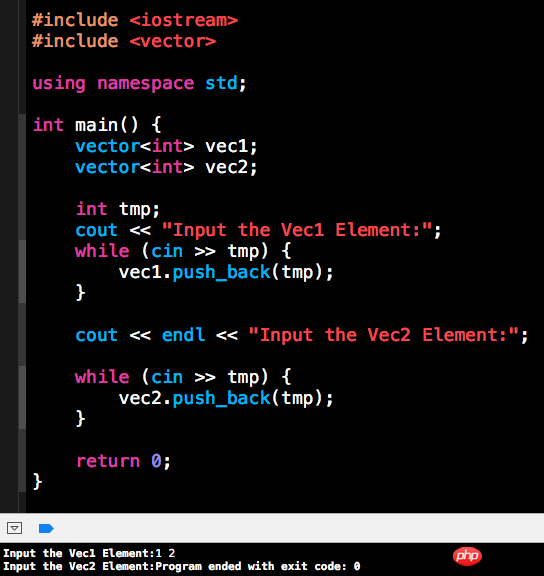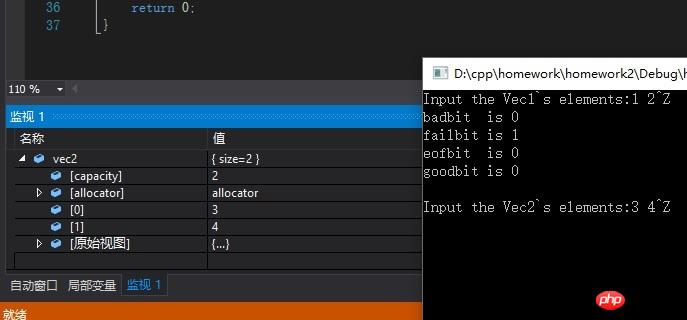问题:为什么我在输入完第一组数据后,输入EOF(Ctrl+D)终止第一组数据输入,第二组数据尚未等我输入即已结束?
相关代码
#include <iostream>
#include <vector>
using namespace std;
int main() {
vector<int> vec1;
vector<int> vec2;
int tmp;
cout << "Input the Vec1`s elements:";
while (cin >> tmp) {
vec1.push_back(tmp);
}
cout << endl << "Input the Vec2`s elements:";
while (cin >> tmp) {
vec2.push_back(tmp);
}
return 0;
}相关贴图(测试环境:Xcode 7.3.1 OSX EI Capitan)
个人思考
思考:个人认为,本问题应该属于缓冲区问题,可能是EOF(Ctrl+D)留在了缓冲中,然后直接被读入第二组数据,从而第二组数据未读取即结束。但我尝试在读取第二组数据前增添诸如 fflush(stdin)等清空输入缓冲等方法后,依旧无效。求各位高人指教,谢谢!
大家讲道理2017-04-17 14:24:23
1.確實是輸入問題,但也是流狀態位的問題。當輸入數字後直接eof會被辨識為字元保存在緩衝中,置位的是failbit而不是eof,輸入數字後回車換行再eof則是eof置位,下面的程式可以反映這一點。
2.如果按題主的程式運行,即便正確的進行了eof,由於第一個while結束以後eof置位,所以第二個while循環還是不會執行。當加入clear()後,只要正確eof就可以實現題主預期,進入第二個while迴圈進行輸入。但如果單純的只是加入clear方法,而輸入時還是直接在數字後面eof時,由於eof被當作字符保存在緩衝中,所以第二個循環開始後,流檢測到緩衝中的字符,還是會置位元failbit導致循環跳出。
3.fflush有用。但要配合cin.clear()使用,因為狀態位元和緩衝是兩個概念,即便清空了緩衝,狀態位元該是啥還是啥。使用fflush之後可以實現不換行直接eof(cin.clear()後面加上cin.ignore()可實現同樣功能)。
環境:win10 64位元+vs2015社群版
#include <iostream>
#include <vector>
#include <stdlib.h>
using namespace std;
int main() {
vector<int> vec1;
vector<int> vec2;
int tmp;
cout << "Input the Vec1`s elements:";
while (cin >> tmp) {
vec1.push_back(tmp);
}
cout<<"badbit is "<<cin.bad()<<endl;
cout<<"failbit is "<<cin.fail()<<endl;
cout<<"eofbit is "<<cin.eof()<<endl;
cout<<"goodbit is "<<cin.good()<<endl;
cin.clear();
cin.ignore();
//fflush(stdin);
cout << endl << "Input the Vec2`s elements:";
while (cin >> tmp) {
vec2.push_back(tmp);
}
//system("pause")
return 0;
}天蓬老师2017-04-17 14:24:23
詳見 c++ reference/istream
#include <iostream>
#include <vector>
int main()
{
std::vector<int> v1;
std::vector<int> v2;
int tmp;
for (; std::cin >> tmp; ) {
v1.push_back(tmp);
}
std:: cin.clear();
for (; std::cin >> tmp; ) {
v2.push_back(tmp);
}
for (int x : v1) {
std::cout << x << ' ';
}
std::cout << std::endl;
for (int x : v2) {
std::cout << x << ' ';
}
std::cout << std::endl;
return 0;
}另外,這不是緩衝問題,是 istream 有個表示 eof 的標誌位,所以 fflush(stdin) 沒用是很正常的。